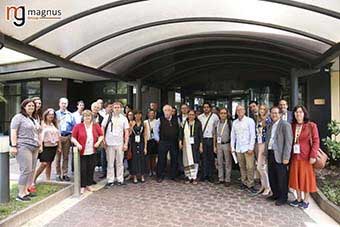COPD 2025_ Event Postponement
This is to inform that due to some circumstances beyond the organizer control, “3rd Edition of International Conference on COPD and Lung Diseases” (COPD 2025) during June 09-11, 2025 at Rome, Italy has been postponed. The updated dates and venue will be displayed shortly.
Your registration can be transferred to the next edition, if you have already confirmed your participation at the event.
For further details, Please contact us at copd@magnusconference.com or call + +1 (702)-988-2320.
Welcome To COPD 2025 | Hybrid Event
We are delighted to invite you to the "3rd Edition of International Conference on COPD and Lung Diseases" (COPD 2025), to be held in the historic city of Rome, Italy. This prestigious event will take place from June 09-11, 2025 gathering researchers, academics, industry professionals, and enthusiasts under the theme "Breathing Life: Advances in COPD Management and Respiratory Health".
COPD 2025 serves as a pivotal platform for researchers pushing the boundaries of respiratory medicine, academics disseminating cutting-edge research, industry professionals driving innovation in pulmonary healthcare, and enthusiasts passionate about improving lung health worldwide. This conference aims to foster collaboration and exchange of insights that will shape the future of COPD management and lung disease treatment.
The conference will cover a wide spectrum of topics crucial to understanding and combating respiratory diseases. From exploring novel treatments and rehabilitation techniques to investigating the impacts of lung diseases on different age groups, including neonates and the elderly, COPD 2025 will delve into pathophysiology, pharmacology, epidemiology, preventive measures and many more. The agenda also includes sessions on critical care, pulmonary hypertension, and emerging challenges such as lung health amidst COVID-19.
Participants can anticipate engaging in enlightening presentations, workshops, and panel discussions where they can present their latest research findings, discuss advancements in diagnostic tools like spirometry, and explore innovative therapies. Whether you are a seasoned researcher or a budding professional in respiratory medicine, COPD 2025 offers a comprehensive platform to learn, collaborate, and network with peers from around the globe.
Join us in Rome, Italy, or virtually, for COPD 2025 as we embark on a journey to enhance our understanding of respiratory health and translate knowledge into impactful interventions. We look forward to meeting you at this pivotal event shaping the future of pulmonary healthcare.
Upcoming Conferences: COPD Conferences 2025 | Pulmonology Conferences | Lung Conferences | COPD 2025
Earlybird Registrations Closes on October 18th 2024
Scientific Sessions
- Chronic Obstructive Pulmonary Disease
- Lung Transplantation
- Pulmonary Rehabilitation
- Cardio Pulmonary Disorders
- Lung and COVID-19
- Neonatal Lung Diseases
- Respiratory Failure
- Respiratory Infections
- Pulmonary Hypertension
- Pulmonary Physiology
- Occupational Lung Diseases
- Lung Cancer
- Streptococcus Pneumonia
- Allergies
- Asthma Management
Past Conference Information
The “2nd International Conference on COPD and Asthma” (COPD 2022) organized virtually by Magnus Group during September 14-15, 2022 with the theme “Breathing in New Approaches and Advances in The Field of COPD and Lung Diseases” was the latest milestone in the field of COPD, Asthma and respiratory disorders.
COPD 2022 Keynote Speakers:
Magnus Group extends its sincere gratitude towards our eminent keynote speakers Jordan B Minov from Institute for Occupational Health, North Macedonia; John Chen, University of Kansas Medical Center, United states; Piotr kusnierczyk, Polish Academy of Sciences, Poland; Gustavo Lionel Knop, Mayo Clinic, United States; George E Chaux, Cedars Sinai Medical Center, United States for your valuable presence and speaking on COPD and workplace.
Upcoming COPD Conferences: COPD Conferences 2025 | Pulmonology Conferences | Pulmonology Conferences 2025 | Asthma Conferences | Asthma Conferences 2025 | Pulmonology Congress 2025 | Asthma Meetings COPD Conference | | Event on Lung Diseases | Pulmonology Events 2025 | COPD Events | Asthma Events 2025 | Asthma Congress | COPD Event 2025 | Lung Diseases Conferences 2025 | Pulmonology Congress 2025 | Asthma Conference 2025 | Lung Diseases Meeting 2025 | COPD Congress 2025 |
Speakers of COPD 2022:
Day-1 speakers:
|
Jordan B Minov |
Institute for Occupational Health |
North Macedonia |
|
Zhirong Zhang |
University of Strasbourg |
France |
|
Tatyana Sarycheva |
Masaryk University |
Czech Republic |
|
Judith Coppinger |
Royal College of Surgeons in Ireland |
Ireland |
|
Catarina Costa Boffino |
Sao Paulo Methodist University |
Brazil |
|
Jose Luis Izquierdo Garcia |
Complutense University of Madrid |
Spain |
|
Hamid Mcheick |
University of Quebec at Chicoutimi |
Canada |
|
Shadi Hamoud |
Rambam Health Care Campus |
Israel |
|
Lisa Curtis |
New Brunswick Community College |
Canada |
|
Robyn Palk |
New Brunswick Community College |
Canada |
|
Tammie Fournier |
New Brunswick Community College |
Canada |
Poster Presentations:
|
Po Ching Huang |
National Cheng Kung University |
Taiwan |
|
Daniela Cardoso |
CHUC |
Portugal |
|
Mariana Conde |
Hospital Center of Tras-os-Montes and Alto Douro |
Portugal |
Day- 2 speakers:
|
Siti Nur Fariza Nordin |
The Canberra Hospital |
Australia |
|
Jirakrit Leelarungrayub |
Chiang Mai University |
Thailand |
|
Saber Soltani |
Tehran University of Medical Sciences |
Iran (Islamic Republic of) |
|
Ram Prasad P L |
SRM medical college hospital and research centre |
India |
|
Jirakrit Leelarungrayub |
Chiang Mai University |
Thailand |
|
Kranti Garg |
Government Medical College |
India |
|
Shimpy Goyal |
Tecnia Institute of Advanced Studies (GGSIPU) |
India |
|
Tszshan Ma |
Emory University |
United States |
|
John Chen |
University of Kansas Medical Center |
United states |
|
Piotr kusnierczyk |
Polish Academy of Sciences |
Poland |
|
Saber Soltani |
Tehran University of Medical Sciences |
Iran (Islamic Republic of) |
|
Gustavo Lionel Knop |
Mayo Clinic |
United States |
|
George E Chaux |
Cedars Sinai Medical Center |
United States |
Upcoming COPD Conferences: COPD Conferences 2025 | Pulmonology Conferences | Pulmonology Conferences 2025 | Asthma Conferences | Asthma Conferences 2025 | Pulmonology Congress 2025 | Asthma Meetings COPD Conference | | Event on Lung Diseases | Pulmonology Events 2025 | COPD Events | Asthma Events 2025 | Asthma Congress | COPD Event 2025 | Lung Diseases Conferences 2025 | Pulmonology Congress 2025 | Asthma Conference 2025 | Lung Diseases Meeting 2025 | COPD Congress 2025
We thank and appreciate all our speakers and delegates for supporting and encouraging us in putting on the conference and propelling us to new heights of success. It also provided an excellent networking opportunity, laying the groundwork for future research and development efforts.
Upcoming Conferences:
Conference Name: 4th Edition of International Public Health Conference
Dates: March 24-26, 2025
Venue: Singapore
Conference Name: 5th Edition of Singapore Nursing Research Conference
Dates: March 24-26, 2025
Venue: Singapore
Conference Name: 8th Edition of Nursing World Conference
Dates: October 17-19, 2024
Venue: Baltimore, MD, USA
Conference Name: 7th Edition of International Cancer Conference
Dates: October 17-19, 2024
Venue: Baltimore, MD, USA
Conference Name: 4th Edition of International Conference on Tissue Engineering and Regenerative Medicine
Dates: September 19-21, 2024
Venue: Rome, Italy
Conference Name: 6th Edition of Euro-Global Conference on Pediatrics and Neonatology
Dates: September 02-04, 2024
Venue: Madrid, Spain
Conference Name: 5th Edition of Cardiology World Conference
Dates: September 05-07, 2024
Venue: Madrid, Spain
Conference Name: 5th Edition of Global Conference on Surgery and Anaesthesia
Dates: September 05-07, 2024
Venue: Madrid, Spain
Conference Name: 2nd Edition of Global Conference on Gynecology & Womens Health
Dates: October 17-19, 2024
Venue: Baltimore, MD, USA
Conference Name: 4th Edition of World Obesity and Weight Management Congress
Dates: October 24-26, 2024
Venue: Baltimore, MD, USA
Upcoming Infectious Diseases Conferences:
Conference Name: 8th Edition of World Congress on Infectious Diseases
Dates: June 09-11, 2025
Venue: Rome, Italy
Name: 7th Edition of World Congress on Infectious Diseases
Dates: October 24-26, 2024
Venue: Baltimore, MD, USA
Upcoming COPD Conferences :
Name: 3rd Edition of International Conference on COPD and lung Diseases (COPD 2025)
Dates: June 09-11, 2025
Venue: Rome, Italy
For Magnus Group Conferences Reviews:
Magnus Group COPD Conferences Reviews | Magnus Conferences Reviews
|
Conference Name |
Date |
Venue |
|
3rd Edition of International Conference on COPD and lung Diseases |
June 09-11,2025 |
The “International Conference on COPD and Asthma” (COPD 2021) organized virtually by Magnus Group during September 22-23, 2021 with the theme Exchange questions, answers and best practices in the field of COPD and Asthma was the latest milestone in the field of COPD, Asthma and respiratory disorders.
COPD 2021 opened with Keynote Presentations which included Allen Fred Fielding from Temple University, USA speaking on The EVALI (Vaping Associated Lung Injury) Epidemic; Ahmed Al-Jumaily from Auckland University of Technology, New Zealand speaking on New trends of pressure oscillation in lung therapy and Jordan B Minov from Institute for Occupational Health of R. North Macedonia, North Macedonia speaking on COPD and workplace.
Upcoming COPD Conferences: COPD Conferences 2025 | Pulmonology Conferences | Pulmonology Conferences 2025 | Asthma Conferences | Asthma Conferences 2025 | Pulmonology Congress 2025 | Asthma Meetings COPD Conference | | Event on Lung Diseases | Pulmonology Events 2025 | COPD Events | Asthma Events 2025 | Asthma Congress | COPD Event 2025 | Lung Diseases Conferences 2025 | Pulmonology Congress 2025 | Asthma Conference 2025 | Lung Diseases Meeting 2025 | COPD Congress 2025 |
Oral Presentations:
|
Sho Shibata |
Tokyo Medical and Dental University |
Japan |
|
Po-Ching Huang |
National Cheng Kung University |
Taiwan |
|
Hamid Mcheick |
University of Quebec at Chicoutimi |
Canada |
|
Nazila Bahmaie |
Near East University (NEU) |
Cyprus |
|
Pooja M R |
Vidyavardhaka College of Engineering |
India |
|
Dipankar Bhattachayya |
Chichuria Institute of Medical Science & Research |
India |
|
Seema Singh |
King Georges Medical University |
India |
|
Hassan Motamed |
Ahvaz Jundishapur University of Medical Sciences |
Iran |
|
Souravh Bais |
SAGE University |
India |
|
Mohammad Rabbani Khorasgani |
University of Isfahan |
Iran |
|
Elham Harati |
Tehran University of Medical Sciences |
Iran |
|
Seyyed Shamsadin Athari |
Zanjan University of Medical Sciences |
Iran |
|
Nightingale Syabbalo |
Nabanji Medical Centre |
Zambia |
|
Nalan Metin Aksu |
Hacettepe University |
Turkey |
Poster Presentations:
|
Shikhar Tripathi |
Anna Medical College & Sir Ganga Ram Hospital |
India |
|
Simon Walsh |
Health Economist, Pfizer |
Ireland |
|
Arben Redjepi |
Cyril and Methodius University in Skopje |
Republic of North Macedonia |
|
Elham Harati |
Tehran University of Medical Sciences |
Iran |
|
Hassan Motamed |
Ahvaz Jundishapur University of Medical Sciences |
Iran |
|
Lyudmyla Kuyun |
Bogomolets National Medical University, Kyiv |
Ukraine |
We thank and appreciate all our speakers and delegates for supporting and encouraging us in putting on the conference and propelling us to new heights of success. It also provided an excellent networking opportunity, laying the groundwork for future research and development efforts.
Upcoming COPD Conferences: COPD Conferences 2025 | Pulmonology Conferences | Pulmonology Conferences 2025 | Asthma Conferences | Asthma Conferences 2025 | Pulmonology Congress 2025 | Asthma Meetings COPD Conference | | Event on Lung Diseases | Pulmonology Events 2025 | COPD Events | Asthma Events 2025 | Asthma Congress | COPD Event 2025 | Lung Diseases Conferences 2025 | Pulmonology Congress 2025 | Asthma Conference 2025 | Lung Diseases Meeting 2025 | COPD Congress 2025 |
For Magnus Group Conferences Reviews:
Magnus Group COPD Conferences Reviews | Magnus Conferences Reviews
Conference Schedule
Opening Ceremony and Introduction
Keynote Session I
Refreshment Break
Keynote Session II
Lunch
Break Out Session I
Refreshment Break
Break Out Session II
Keynote Session III
Refreshment Break
Break Out Session III
Lunch
Poster Presentations
Refreshment Break
Break Out Session IV
Keynote Session IV
Refreshment Break
Break Out Session V
Lunch
Break Out Session VI
End Note Session and Closing Ceremony
Get in Touch Make Inquiry
Please feel free to contact us for any information, all the queries will be answered by the conference secretariat within 24 hrs.
Photo Gallery (Our Past Events)
Testimonials

I want to thank for the tremendous work on the organization of the forum and the success of the event. Impressions are the most positive. I hope for further meetings and wish you all good luck.

It was fruitful meeting and there were many interesting presentations from the field of plant science and biotechnology

Thank you very much for such a wonderful Congress! I was very glad to spend these wonderful days with you. I hope to see you soon.

It was well attended with very timely presentation. Once again, this was one of the best organized international conferences I have ever had.
Important Alert:
X







